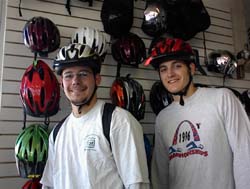|
Rules
for riding
Spring brings need for bicycle
safety
[APRIL
26, 2000] Spring, with its lengthening
days and warm weather, brings people of all ages outdoors.
Many of them, about 67 million every year, will be riding
bicycles. In 1998,
761 of those bicyclists were killed in traffic-related accidents,
and over 500,000 more were admitted to hospital emergency rooms
because of bicycle-crash injuries, according to the National
Highway Traffic Safety Administration.
|
|
Bert
Rawlings, owner of Lincoln Cycle Center, thinks something can be
done to lower those statistics.
He cites six rules:
Rawlings, who gives talks on
bicycle safety to third, fourth and fifth graders in Lincoln’s
District 27 schools, especially stresses the use of helmets.
While it is not the law in
Illinois that everyone riding a bike must wear a helmet, Rawlings
thinks it should be. Wearing
a helmet is one of the best safety precautions any rider can take
and one of the best safety devices parents can buy their
children.
He can tell you why. According
to the U.S. Department of Transportation, 98 percent of bicyclists
killed were not wearing helmets.
Studies on the effectiveness of bicycle helmets in
preventing serious head injuries (which account for more than 60
percent of bicycle-related deaths) show two important facts:
Rawlings emphasizes that
manufacturers are working hard to make helmets lightweight and
comfortable, and that it isn’t a chore to get used to wearing
them.

[Lincoln
College students Paul Yehling (left) and
Josh Wegrzyn try on
bicycle helmets at
Bert Rawlings’ Lincoln Cycle Center.]
Be sure you are riding a safe
bike, he tells the young people he talks to.
If there is something broken on your bicycle, fix it before
you ride it. Everything on your bicycle is an important part of the
machine and should be in good working order.
Tires should be properly inflated, cables taut and unfrayed,
chain lubricated and wheels true.

Be sure you can be seen,
Rawlings says. During
the day, cyclists should wear bright clothing.
Earth-tone bicycle clothing is fine for the trail, but
Screaming Yellow and Safety Orange are best for road riding.
If you must ride at night, wear reflective clothing and a
white helmet that will bounce back motorists’ headlights.
Also, the law in Illinois now says that anyone riding at
night must have a headlight that can be seen for at least 500 feet
and a rear red reflector that can be seen up to 600 feet.
|

Be aware of where you are and
what’s going on around you. Even
though you should dress so you can be seen, you should ride as if
you’re invisible, Rawlings says.
If you think a person in an automobile can’t see you,
you’ll ride more responsibly.
Other tips on being aware are
to be hyper-alert when turning and crossing intersections.
Almost one-third of bicycle accidents occur at intersections.
Signal turns half a block before the intersection, using the
correct hand signals. If
traffic is heavy and you must turn left, dismount and walk the
bicycle across both streets at the crosswalks.
Before entering the traffic flow, stop and look both ways
carefully.
Being predictable means
following the safety rules recommended by the state of Illinois.
A small handbook explaining these “Bicycle Rules of the
Road” can be picked up at any driver’s license facility.
Bicycle riders, like motorists,
should be on the right side of the road and should follow the same
general rules that motorists do, while staying as close to the right
edge of the road as is practical.
They should ride single file and one to a bike.
Like motorists, bike riders should use hand signals to let
the traffic behind them know what they are going to do (left arm
straight out for left turn, forearm up for right turn, forearm down
for stop). Bicycle
riders should also know the shape and color of warning signs, such
as the stop sign and the railroad crossing sign.
Although many bicyclists’
greatest fear is that a car will overrun them from behind, that is
actually a rare occurrence, according to a Federal Highway
Administration research study. Seventy percent of bicycle accidents are the result of
erroneous or careless behavior by the cyclist.
Behaviors such as riding into a street without stopping,
turning left or swerving into traffic that is coming from behind,
running a stop sign or riding against the flow of traffic are much
more likely to cause accidents than being run over by a car from
behind.
Every group concerned with
bicycle safety – the League of American Bicyclists, the National
Safety Council, cycling guru and transportation engineer John
Forester and Lincoln’s own Bert Rawlings – repeats the same
thing. Wear a helmet.
As the National Safety Council
puts it, “When you consider that the first body part to fly
forward in a collision is usually the head, with nothing but skin
and bone to protect the brain, it’s a tip worth repeating.”
[Joan
Crabb]
|



